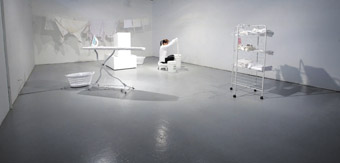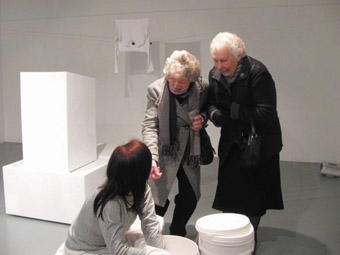spin cycle
judith abell: philippa steele, white wash

Philippa Steele, White Wash
photo Sean Fennessy
Philippa Steele, White Wash
INITIALLY UNAWARE OF THE IRONY, I QUICKLY SORT THROUGH MY CLOTHES BEFORE I LEAVE HOME, PLACING DELICATE ITEMS IN PROTECTIVE NET BAGS. CAP FULL OF LIQUID. CLIP THE CIRCULAR DOOR SHUT. A MULTITUDE OF BEEPS TO FIND THE RIGHT CYCLE. PRESS “GO”. LEAVE. MY DESTINATION IS WHITE WASH, WHERE ALL OF THE STEPS IN MY TWO MINUTE PROCESS AND THE ENSUING WASH, ARE RECLAIMED BY ARTIST PHILIPPA STEELE IN AN ACT OF SLOW DEDICATION.
A soft sloshing greets me as I enter. The diminutive artist is perched on a small white stool, her white gloved hands working away steadily at a white towel immersed in one of a number of similarly monochrome buckets. Surrounding the artist are a series of ‘stations’ that offer the tools required to sort, tag, rinse, wash, wring, dry, iron and set aside for collection. Each station is stripped to the bare minimum. Apart from the electric iron and the small white laptop for entering data, there are no smooth whitegoods or unwarranted beeps. The smell of clean clothes surrounds us. Everything is white.
Every week we wash. This has gone on ever since we began our long obsession with cleanliness and desired for more than the clothes on our backs. For most, the experience matches my opening sentences—a quickly executed series of steps with coffee, toast or child in the other hand, followed by a reluctant hanging out, sometime later.
This year Steele completed a six month stint living and working in India. As with many before her, the experience has had a profound effect on the way that she views her daily existence and consequently her art practice. Prior to this journey, her work focused on the object or what she likes to call ‘thingness’ and a process of identifying and removing associations that defines any one thing, with the difficult ambition of achieving ‘nothingness.’ Through observation of the devotional attention to everyday processes in India, Steele has made a lateral shift, focusing her intimate, intense attention on the action.
The set up is sublimely simple. The artist is offering to handwash people’s clothes. Steele’s advertisements in the local paper and flyers placed with nearby businesses invite members of the public to bring in white items for washing, with the provocative tag line “I WANT YOUR DIRTY WHITE LOAD.” All items are entered into a database, sorted according to necessary treatment (soak, starch, iron etc), tagged and then laundered by the artist within the gallery space throughout the three week exhibition. Just as in any other service industry, Steele states that she aims to be “friendly, approachable and professional.” There is no charge.

Philippa Steele, White Wash
photo Sean Fennessy
Philippa Steele, White Wash
While simple in set up and aesthetically austere, the translation of this daily process into a gallery show creates a layered, powerful work, which unfolds as you spend time in the space. There are obvious links to the lowly paid labour of those within the service industry, particularly in the developing world. Steele’s refusal of payment amplifies this transaction and she notes that some ‘customers’ express discomfort with the arrangement. The work clearly highlights the disconnection that Westerners now have from the details of daily life, but for Steele I think the most resonant aspect of the work is the potential for meditation through the action. She has found herself perfectly absorbed in the simple steps of washing and feels that she has achieved active meditative states. The tiny, tiny details like the fine fibres impossible to remove entirely and the vast variation in ‘whites’ have found their way to her attention. Her intent, I believe, is for everyday moments of spirituality reached through quiet observation.
The artist acknowledges and embraces the inherent contradictions in the work. In attempting to remove associations through stripping away and ‘whitening’, Steele succeeds in bringing every single object into focus, with items like the electric iron and plastic coated hangers reading like iconic artefacts. Placing the work within a sterile gallery context brings with it an ironic sense of disconnection with her Indian experience as this cool white room is surely no match for the humming, sensory environment in which she first recognised the potential in these acts. And I wonder about the actuality of meditative states for those whose life offers no choice but to wash in this manner.
I leave the gallery to the soft slap of towels against the washing plinth and look back to the shadow of the action against the white walls. Some minutes after I arrive home, sing song beeps signal that my wash is complete. As I shake out each item and hang it on the drying rack, I take stock. I notice the soft snap as I shake the clothes, I watch my hands as I place each item to maximise drying and I reflect that a little of Steele’s attention has quietly travelled out of the gallery along the road and into my home, my hands, my work.
Philippa Steele, White Wash; Inflight Gallery, Hobart, July 4–26
RealTime issue #87 Oct-Nov 2008 pg. 54






